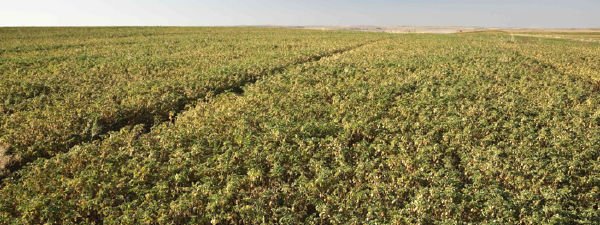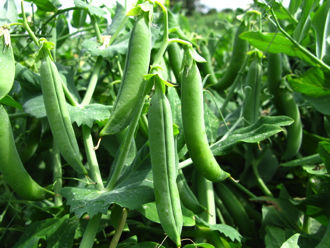7 Ways to Improve Weed Control in Wheat-Pulse Rotations
February 4, 2019

Pulses have become an increasingly popular way to replace fallow. Pulses can help increase profitability and soil health in cereal fields, giving growers a better financial return and new ways to manage weeds.
These top-notch cultural practices can give both wheat and pulses the best advantage – and help you get the most out of your herbicide.
How to Manage Weeds in a Wheat-Pulse Rotation
1. Start the Season with Healthy Crops:
“One of the best weed-control methods is to establish the healthiest crop possible, whether you're in pulses or cereal grains,” says Ed Davis, research scientist and herbicide specialist at Montana State University. “The goal is to get the crop out of the ground as soon as possible with uniform emergence, then vigorous growth to quickly close the canopy. Then you’re funneling resources to the crop rather than the weed.”
2. Consider Your Seeding Rates, Dates and Spacing:
“We saw that if we bumped up our seeding rate to about 18 plants per square foot, we could make our lentil crop more competitive with weeds,” says Brian Jenks, weed scientist at North Dakota State University. “Also, using different planting dates can help keep weeds off balance. In some cases, row spacing can be used to our advantage, such as soybeans in 15” rows instead of 30” rows.”
Chris Westergard, a Montana wheat farmer, says early seeding in the first part of April gives him a leg up against weeds. “Get stuff in the ground so you get the best shot at growth,” he advises.
To that end, Jenks stresses the importance of checking equipment to make sure it is clean. “I heard of a grower who purchased a combine, and now has waterhemp in his field because that combine had waterhemp seed in it,” he says.
3. Clean Tanks Thoroughly:
“Some of the grass-killer chemistries used on emerged lentils and peas are very good solvents, especially with the adjuvant,” Davis says. “They’ll pull years of residues out of poly tanks, hoses and nozzles. First-time pulse growers with a history of using the same sprayer for everything can start out with a beautiful pulse crop, then wind up damaging it.” Clean tanks thoroughly or use a designated one for pulses, he says.
4. Use Pulses In Your Crop Rotation Plan:
Pulses in a wheat rotation introduce one of the best weed-control benefits there is: Diversity.
“Diversity is the best practice,” Jenks says. “From an agronomic perspective, we need good crop diversity and herbicide mode-of-action diversity. That means cool-season versus warm-season crops, winter wheat versus spring wheat, short-season versus long-season, fall- versus spring-planted, annual versus perennial crops.”
5. Give Crops a Fighting Chance Against Weeds:
A more diverse rotation leads to healthier crops that can fight against weed pressure more effectively, Davis notes. “I believe Mother Nature despises bare ground,” he says. “The weeds we deal with in Montana are pretty opportunistic. Mother Nature always has remedies for whatever we throw at her.”

Jenks recommends growers work in warm-season crops such as soybeans and sunflowers in addition to the cool-season pulses. “We're trying to keep the weeds off-balance, so we're not always spraying the herbicides at the same time of year,” he says.
In Westergard’s area of the country, where the growing season is short and winters are cold, he plants spring grain such as durum. A typical rotation might be peas, then durum and then lentils, “sometimes with canola or something different,” he says. “If you're doing pulses too often, you can really get into trouble with a whole lot of weeds, because weed control in pulses takes a little more management.”
6. Diversify Your Herbicide Choices:
A diversified system includes changing up herbicides, not just crops. “Herbicides fit into the train of thought in agriculture that the more diverse a system, the more sustainable it is,” Davis says.
Jenks says this includes residual- versus post-treatments, pre-emergence versus post, different modes of action, and tank mixes. “This will help us preserve the Group 1s and Group 2s so they are still effective for us,” he says.
A Group 2 herbicide like Varro® provides wheat growers a valuable asset: flexibility. With Varro, growers can treat grass weeds in their wheat crop without jeopardizing crop safety or their rotational crop, and helps growers get the most out of their pulses.
Pulses in a wheat rotation compel you to diversify your herbicide choices, which can reduce weed pressure in the subsequent cereal crop. “It helps that we can use different modes of action in the pulse crop,” says Jenks. “In the pulse crop, we could also use a Group 3 or Group 15. In that sense, rotating to a pulse crop does help with weed control overall.”
7. Plan Multi-Year Crop Rotations:
Extended rotations also help minimize herbicide resistance. “The more diverse the rotation, the more opportunities for different herbicides that fall into different groups or modes of action,” Davis says.
As an added bonus, diversifying your rotation with a multi-year outlook in a wheat rotation cuts down on disease risk, a growing problem in areas where the same pulse crop is grown every other year.
Check out the Cut Down on Weed Control Risks in Pulse Crop Rotations article for tips on how to successfully switch between rotations while maintaining effective weed-control practices.
©2019 Bayer Group. Always read and follow label instructions. Bayer, the Bayer Cross, and Varro are registered trademarks of Bayer Group. Varro is not registered in all states. For additional product information, call toll-free 1-866-99-BAYER (1-866-992-2937) or visit our website at www.CropScience.Bayer.us. Bayer CropScience LP, 800 North Lindbergh Blvd. St. Louis, MO 63167.